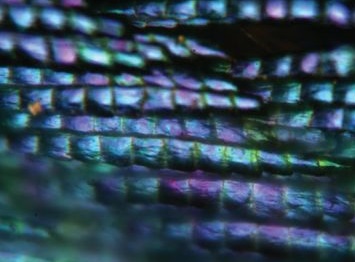Recent work, published in Journal of the Royal Society Interface, shows that the iridescent colours can be quantitatively explained by optical multilayer modelling. We asked the authors, Doekele G. Stavenga and Bodo D. Wilts, some questions about their research.

Many birds have brilliantly coloured, iridescent feathers. A very common example is the mallard (Anas platyrhynchos), with the blue-coloured speculum of both the male and female, and the green head feathers of the male. The iridescent colours arise from light interacting with stacks of melanosomes, melanin-pigment containing organelles, present in the feather barbules.
Recent work, published in Journal of the Royal Society Interface, shows that the iridescent colours can be quantitatively explained by optical multilayer modelling. We asked the authors, Doekele G. Stavenga and Bodo D. Wilts, some questions about their research.

A speculum feather (Figure 1 DOI: 10.1098/rsif.2017.0407)
Why are ducks’ features so colourful?
Many birds are very colourful, but notably the males, to be attractive to the females. In ducks, structural coloured feathers are found in both males and females (though in the latter restricted to the speculum) which might help in intraspecific recognition.
What has previous work told us about the structure of duck feathers?
Heinz Durrer from the University of Basel published comprehensive anatomical studies on bird feathers from 1962 to 1986. In this pioneering work, Durrer demonstrated that many bird feathers have orderly organised melanosomes, cellular structures containing melanin, embedded in the feather’s keratin. Together, these structures are essentially acting as multilayers reflectors. Recent work focussing more on the optical properties of duck feathers has shown that they have a universal design motif.
What is ‘optical multilayer theory’?
An optical multilayer is a stack of layers, thin films, each having a refractive index different from the refractive indices of the adjacent layers. A well-known example of a thin film is a soap bubble, which derives it colours due to light interference in the thin soap layer. Light interference effects are enhanced in a multilayer of such thin films. The reflectance and transmittance of any such stack can be easily calculated with a matrix multiplication procedure. Many animals, including beetles, butterflies, and birds, have multi-layered features in their outer covering, providing them with so-called structural colours.
How did you combine microscopy with modelling to find out what you did?
We combined anatomical data and previously determined refractive indices of melanin and keratin to calculate reflectance spectra, and compared the results with spectroscopic measurements performed with a conventional light microscope and a fibre-optic goniometer.
How has this work helped further our knowledge about feather colouration? And why is it important?
Our approach has now created detailed quantitative understanding of the duck’s feather coloration, which will be helpful to achieve further knowledge of bird feather colours in general.
Studies of natural colours are important as inspiration for applied research, for example in biomimicry or to extract novel design principles for optical materials. In particular, we found that the optical structure in the duck feather is surprisingly robust to local disorder, which might in fact be employed in optical materials.
Doekele G. Stavenga is Professor of Computational Physics at the University of Groningen. His co-authors, Casper van der Kooi and Bodo D. Wilts, are based at the University of Lausanne and the University of Fribourg (Switzerland), respectively.
Main image
Closely packed barbules in a central area of the blue iridescent area of the intact feather (Figure 2 DOI: 10.1098/rsif.2017.0407)
